How I Do It: Connecting with Colleagues in a Shared Community of Practice by Karen Natoci Florka
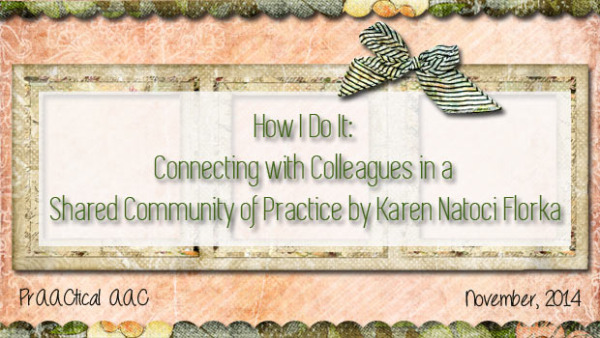
I had the pleasure of meeting Karen Natoci Florka last month when I visited Michigan and am delighted that she was willing to introduce us to the Shared Community of  Practice from the team at The Communication Matrix. Karen is an SLP who has served students aged 3-26 with various physical, sensory and intellectual challenges at Wing Lake Developmental Center (Detroit area) since 2001. She is a part time lecturer at Wayne State University where she teaches a course entitled “Communication Acquisition and Educational Interventions for Students with Moderate to Severe Impairments.” She is part of the Communication Matrix Charter group. Click on the image below to learn more.
Practice from the team at The Communication Matrix. Karen is an SLP who has served students aged 3-26 with various physical, sensory and intellectual challenges at Wing Lake Developmental Center (Detroit area) since 2001. She is a part time lecturer at Wayne State University where she teaches a course entitled “Communication Acquisition and Educational Interventions for Students with Moderate to Severe Impairments.” She is part of the Communication Matrix Charter group. Click on the image below to learn more.
The Communication Matrix is growing into a Shared Community of Practice!
I remember the first few weeks in my new job at a wonderful, magical, school for children with complex communication needs. It was time for my first evaluation. These 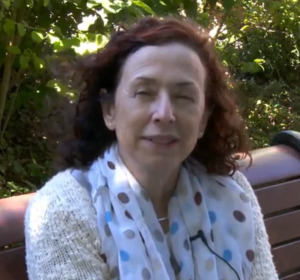 amazing students were challenging! They seemed to have many more needs. I wasn’t sure if they were showing “joint attention to a shared object or picture. The overall expectations at that time were very low. Most of the caregivers, teachers and families were satisfied if the child responded when talked to or when shown a toy by smiling, laughing, or by looking at the stimulus. Was this educational? Was this communication? When students exhibited an attempt to communicate via screams, vocalizations or body movements, they might have been reprimanded, told to “be quiet.” We didn’t know to give them an alternative, more appropriate way to communicate. Instead, in those days, students were taught to sit, be passive, and accept hand over hand as prompts.
amazing students were challenging! They seemed to have many more needs. I wasn’t sure if they were showing “joint attention to a shared object or picture. The overall expectations at that time were very low. Most of the caregivers, teachers and families were satisfied if the child responded when talked to or when shown a toy by smiling, laughing, or by looking at the stimulus. Was this educational? Was this communication? When students exhibited an attempt to communicate via screams, vocalizations or body movements, they might have been reprimanded, told to “be quiet.” We didn’t know to give them an alternative, more appropriate way to communicate. Instead, in those days, students were taught to sit, be passive, and accept hand over hand as prompts.
I knew this simply was NOT enough. The students were taught to be passive and to NOT communicate. Fortunately, we had a new supervisor who in the unique position to fully encouraged me to look outside of our county… the nation… to search for current best practices and update our philosophy on what it means to communicate. Thankfully, I found these sites: National Joint Committee for the Communication Needs of Persons with Severe Disabilities (NJC) and “The Communication Bill of Rights.” My internet search took me to: The Communication Matrix and the Design-to-Learn website. I scoured every word. For the first time, ALL behaviors were considered a “CAN DO” ABILITY! Behaviors ‘were’ part of communication and a necessary step in the developmental process. Finally, even the most awkward of behaviors could be regarded in a positive manner, and be associated with authentic, legitimate communication intent.
The Communication Matrix is now used regularly in our school. We encourage parents to fill out the Parent version of the Matrix. We compare results at the IEP meetings and collaborate on crafting communication goals in a positive way. Here’s an example of such an objective for a little girl who is communicating at a level II. She needs practice making choices via partner assisted scanning: Suzy will independently use their preferred communication means during partner assisted scanning (i.e., look at, reach, facial expression, vocalize, voice output device, body movement) to indicate a choice when offered an array of three objects/large clear symbols presented one at a time in 75% of opportunities given wait time, expectant pausing and verbal encouragement.
Now, The Communication Matrix has expanded into a growing Community of Practice Below is a video describing it.
Everyone is welcome to visit, create a profile, and check out this new online community built around the Communication Matrix. The community is designed to help professionals and parents share tools, ideas, and challenges as they help support individuals with complex communication needs. Membership is free and open to all. Participants are welcome to view and write posts in the Forum, see what our current guest Moderator, Gayl Bowser recommends in our Community Library, and visit the Shared Science section to see information about how individuals with specific disorders communicate (using data drawn directly from the assessments that users have contributed to the Communication Matrix database).
The Communication Matrix Community will thrive with the involvement of members like us! Take a look!
Filed under: PrAACtical Thinking
Tagged With: collaboration, Communication Matrix, Community of Practice, connection, How I Do It, Karen Natoci Florka
This post was written by Carole Zangari
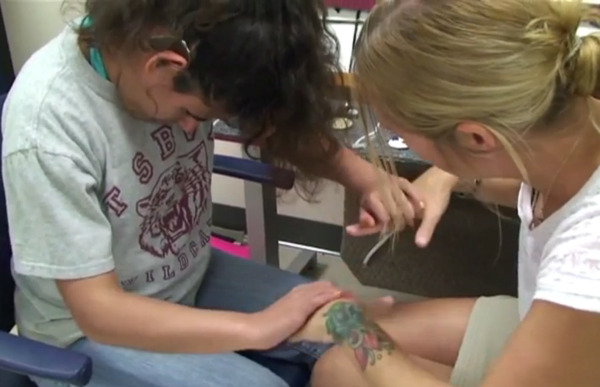



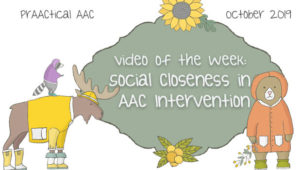
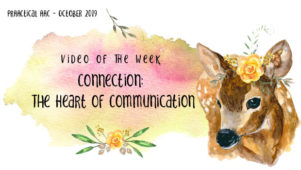
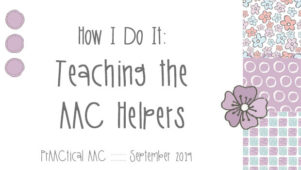
3 Comments
I love the “can do” attitude so much it is now on my license plate! I am so thrilled about this new community/blog.
Thank you for this article & video about the shared community of practice – I’m heading on over to join there right now. I wanted to give a quick heads up to you & the folks who developed the video -the URL at the end of the video leads to a domain selling site. I think the URL should be .org and it’s showing as .com on the video. If you can add it into your blogpost, it might help others find it a little more easily so the community can grow even larger! The correct URL should be: https://community.communicationmatrix.org/ It’s hyperlinked through the “forum” word in your last paragraph but if folks type it in based on the video, they won’t get it.
Thanks for all your postings, they are so very helpful!
Thanks, Lisa!I will work on that. 🙂